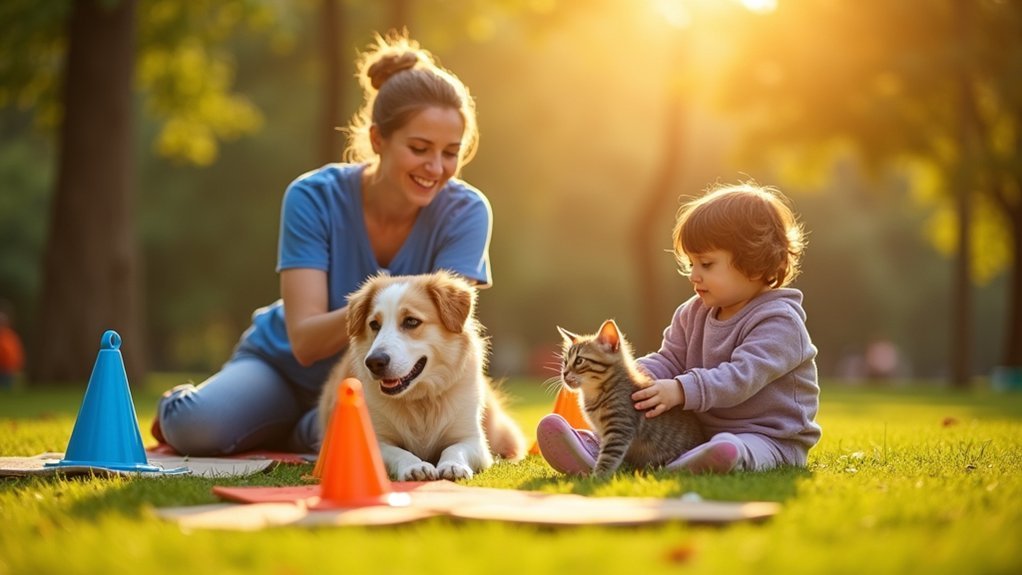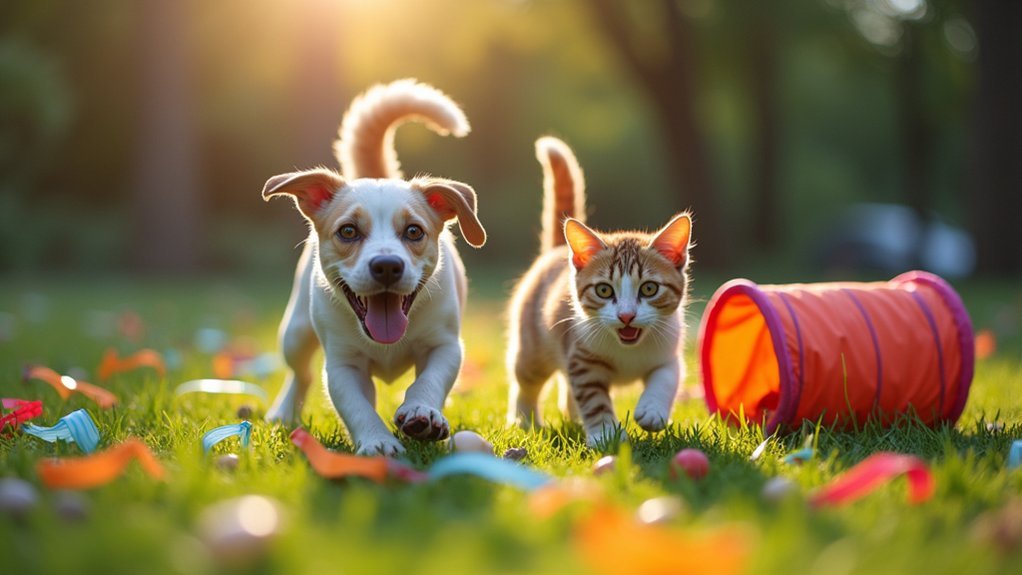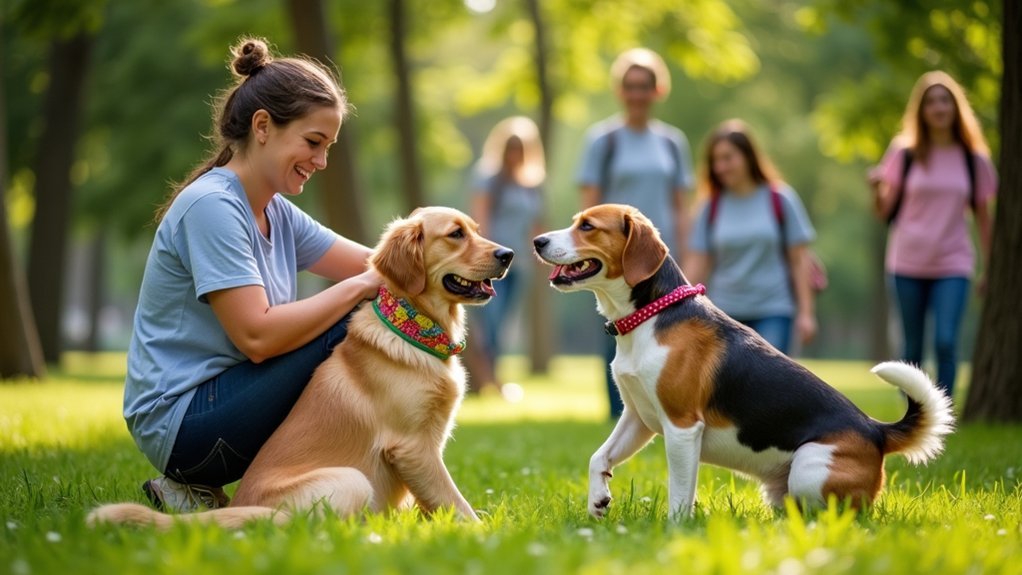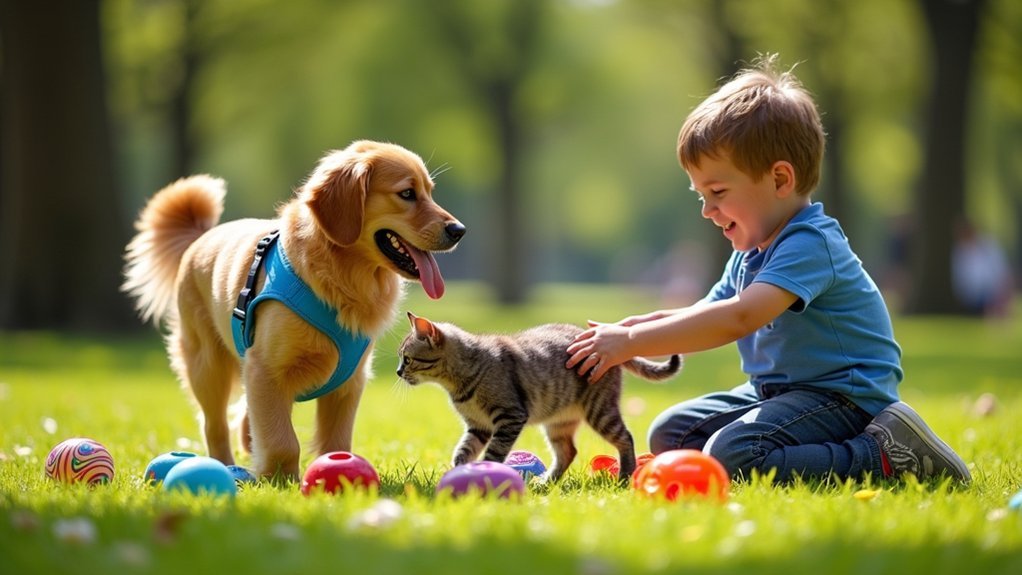Creating activities for special needs pets requires understanding their unique limitations and abilities. For mobility-challenged animals, use adaptive equipment like wheelchairs or harnesses. Stimulate blind or deaf pets with textured toys, scent games, or vibrating devices. Offer cognitively challenged pets modified puzzles with adjustable difficulty levels. Keep exercise low-impact with swimming or short walks on soft surfaces. Maintain consistent routines and use positive reinforcement. With these tailored approaches, you’ll discover how remarkably adaptable your special companion can be.
Understanding the Unique Needs of Special Needs Animals

When caring for special needs animals, recognizing their distinct challenges is the first step toward providing appropriate care. Your pet’s condition might fall into categories like physical disabilities, sensory impairments, chronic medical conditions, or behavioral issues resulting from past trauma.
You’ll need to assess your pet’s specific limitations and abilities. Animals with physical disabilities require different accommodations than those with sensory impairments or anxiety disorders. Pay attention to behavioral cues that might indicate pain, discomfort, or anxiety.
Many special needs pets display emotional sensitivities to environmental changes, loud noises, or certain handling techniques. Animals with sensory disabilities such as deafness can be taught sign language and may need special communication methods.
Remember that despite these challenges, special needs pets often demonstrate remarkable adaptability. With proper understanding and patience, you can develop activities that enhance their quality of life while respecting their limitations.
Adaptive Equipment for Mobility-Challenged Pets
For mobility-challenged pets, the right adaptive equipment can transform their daily lives from frustrating limitations to empowering independence.
Wheelchairs and mobility carts allow dogs with injuries or disabilities to run and play again, while traction pads provide essential grip on slippery surfaces.
You’ll find various options to address specific mobility issues—hind-end harnesses support pets struggling with rear leg weakness, while knee and carpal braces stabilize painful joints.
Most equipment comes in adjustable sizes and can be customized to your pet’s unique needs. Many top-rated pet wheelchairs are designed with easy adjustability in height, width, and length to ensure the perfect fit for your companion.
Trusted brands like Walkin’ Wheels and Golden Wags offer quality products worth considering.
Beyond physical benefits, these devices boost your pet’s confidence, encourage exercise, and improve their social interactions—all contributing to enhanced emotional well-being and quality of life.
Sensory Enrichment Activities for Blind and Deaf Animals

Blind and deaf pets experience the world through heightened non-visual and non-auditory senses, opening up unique opportunities for enrichment. You’ll find they rely heavily on smell and touch, which can become powerful tools for engagement and stress reduction. Interactive toys like the Snuffle Mat encourage natural foraging behaviors while stimulating their powerful sense of smell.
| Sense | Activity | Benefit |
|---|---|---|
| Smell | Scent detection games | Builds confidence |
| Smell | Treat hide-and-seek | Encourages exploration |
| Touch | Textured mats | Provides sensory mapping |
| Sound/Vibration | Vibrating toys for deaf pets | Creates tactile awareness |
| Combined | Multi-sensory play areas | thorough stimulation |
Create a rotation of enrichment activities that combine different sensory experiences. For blind pets, use scented toys and textured surfaces. For deaf animals, incorporate vibrating toys and visual cues. Regular tactile interaction through massage also strengthens your bond while reducing anxiety.
Mental Stimulation Games for Pets With Cognitive Disabilities
Mental stimulation for pets with cognitive disabilities can begin with slow-paced scent work that engages their natural tracking abilities while accommodating processing limitations.
You’ll find modified memory puzzles particularly effective, as they offer adjustable difficulty levels to match your pet’s changing capabilities without causing frustration.
Adaptable target training provides structured learning opportunities that you can tailor to your pet’s cognitive strengths, reinforcing successful behaviors while maintaining their confidence and interest. Consider incorporating positive reinforcement techniques during obedience training sessions, which remain viable and beneficial for pets with special needs.
Slow-Paced Scent Work
Five powerful benefits emerge when introducing cognitively disabled pets to slow-paced scent work. This activity enhances mental stimulation while respecting limitations, reduces anxiety, builds confidence, maintains cognitive function, and adapts to various environments.
Dogs experience the world primarily through scent—their olfactory capabilities exceed ours by up to 100,000 times. This makes scent work particularly engaging for their brains while providing positive sensory experiences that can override anxiety. The dedicated olfactory lobe in canine brains processes scent information extensively, making smell-based activities naturally stimulating even for dogs with special needs.
| Experience Level | Recommended Activity | Time Frame |
|---|---|---|
| Beginner | Hidden treats in easy containers | 5-10 min |
| Intermediate | Scented toys in visible locations | 10-15 min |
| Advanced | Multiple scent stations | 15-20 min |
| Expert | Scent trails with rewards | 20-30 min |
When implementing activities, start simple and adjust based on your pet’s responses. Use high-value rewards and pet-safe materials to maintain interest.
Modified Memory Puzzles
Moving from scent work to another form of enrichment, modified memory puzzles offer specialized mental exercises for pets with cognitive challenges. These puzzles can be tailored to your pet’s specific abilities while providing essential mental stimulation.
When selecting or creating memory puzzles for your special needs pet, consider:
- Start simple – Choose puzzles with reduced complexity or create DIY versions that match your pet’s current cognitive abilities.
- Incorporate sensory elements – Add different textures, smells, or sounds to enhance engagement. Regular engagement with these puzzles creates new neural connections through neuroplasticity, improving your pet’s cognitive function over time.
- Use consistent rewards – Help your pet make positive associations with puzzle-solving activities.
- Gradually increase difficulty – Build your pet’s confidence by slowly introducing more challenging elements as they progress.
Nina Ottosson puzzles are popular commercial options, offering multiple difficulty levels and easy-to-clean designs.
Adaptable Target Training
Adaptable target training offers a powerful method to engage pets with cognitive disabilities while providing essential mental exercise. This technique teaches your pet to touch a specific object with their nose or paw, rewarding precision and focus.
You can customize targets to suit your pet’s sensory needs—using quieter materials for noise-sensitive animals or high-contrast colors for those with visual limitations. Start with simple targets and gradually increase complexity as your pet gains confidence.
For pets with cognitive challenges, incorporate the training into daily routines for consistency. Use clear cues, whether verbal, visual, or tactile, depending on what works best for your companion. Positive reinforcement is crucial when working with special needs pets, as it builds trust while establishing a supportive learning environment.
The benefits extend beyond mental stimulation—you’ll notice improved focus, enhanced communication, and increased confidence as your pet masters new skills.
Creating Safe Exercise Routines for Physically Limited Animals
You’ll need to incorporate low-impact movement options like gentle swimming or short walks to keep your physically limited pet active without causing strain or pain.
Consider investing in adaptive equipment such as pet wheelchairs, support harnesses, or padded ramps that can dramatically improve your companion’s mobility and independence.
These specialized tools can transform your pet’s exercise experience, allowing them to build strength safely while enjoying activities they might otherwise miss. Maintaining consistent routines will help your pet navigate their physical limitations with greater confidence and security.
Low-Impact Movement Options
When caring for physically limited animals, creating safe exercise routines becomes essential for maintaining their health without causing pain or injury. Low-impact movement options provide the perfect balance of activity without stressing joints or exacerbating existing conditions.
Consider these gentle exercise alternatives for your special needs pet:
- Walk on grass or dirt trails instead of concrete to reduce joint impact while still providing outdoor stimulation.
- Try swimming or hydrotherapy sessions, which offer full-body workouts with minimal stress on the body.
- Incorporate indoor activities like hide-and-seek or puzzle toys that engage your pet mentally while limiting physical strain. Commercial or homemade brain teasers can keep disabled or senior dogs mentally active while requiring minimal physical exertion.
- Engage in gentle play like modified tug-of-war on soft surfaces or using short tunnels for smaller breeds.
These options keep your pet active while respecting their physical limitations.
Adaptive Equipment Solutions
For pets facing mobility challenges, the right adaptive equipment can transform daily activities from frustrating struggles into achievable routines. Custom wheelchairs, harnesses, and supportive slings can help your special needs pet maintain mobility while reducing physical stress.
When selecting equipment, prioritize proper fit and comfort. Ill-fitting devices can cause skin irritation or discomfort. You’ll need to monitor your pet regularly and make adjustments as they heal or grow.
Work with your veterinarian to integrate adaptive devices with rehabilitation therapy. This combination maximizes benefits, helping your pet build strength and improve coordination while maintaining safety. Devices designed for pets with limited mobility provide opportunities for them to work their bodies and minds despite physical limitations.
Though specialized equipment can be costly, the improvements in your pet’s quality of life—increased independence, reduced frustration, and greater participation in family activities—make these investments worthwhile.
Building Socialization Opportunities for Behaviorally Challenged Pets

Pets with behavioral challenges face unique obstacles in social development that require thoughtful intervention and structured support.
You’ll need a strategic approach that builds trust while respecting your pet’s limitations. Start by identifying specific triggers and introducing controlled exposure at your pet’s pace. Consider consulting with a veterinary behaviorist for personalized guidance tailored to your pet’s specific needs.
- Create predictable routines around social interactions, allowing your pet to develop confidence through consistency.
- Use positive reinforcement exclusively, rewarding calm behavior with treats or toys to create positive associations.
- Arrange structured meet-ups with well-socialized animals in neutral, quiet environments.
- Establish safe zones where your pet can retreat if overwhelmed, giving them control over their socialization experience.
Never force interactions—successful socialization happens gradually as your pet builds emotional safety through repeated positive experiences.
Frequently Asked Questions
How Do I Fund Specialized Equipment for My Special Needs Pet?
You can fund specialized equipment for your special needs pet through foundations like Handicapped Pets Foundation, Joey’s P.A.W, or The Pet Fund. You’ll also find success with community fundraising and FSA funds.
Can Special Needs Animals Participate in Community Pet Events?
Yes, you’ll find many community pet events welcome special needs animals. You can participate in modified pet walks, playgroups, adoption days, and educational workshops designed with accommodations for your pet’s unique requirements.
When Should I Consider Hospice Care Versus Adaptive Activities?
Consider hospice care when your pet has a terminal illness with days to weeks left or unmanageable suffering. Choose adaptive activities when your pet has stable conditions and can still enjoy modified engagement with proper support.
How Do Insurance Policies Cover Special Needs Pet Care?
Most insurance policies cover newly acquired disabilities but exclude pre-existing conditions. You’ll find coverage for assistive devices, rehabilitation, and ongoing treatments varies. Consider customizable plans that allow you to adjust for your pet’s changing needs.
Are There Certification Programs for Special Needs Animal Caregivers?
Currently, there aren’t specific certifications for special needs animal caregivers. You’ll find related training through general programs like CACW or veterinary assistant courses, but you’ll need to supplement with specialized workshops and on-the-job experience.
In Summary
You’ll make a tremendous difference in your special needs pet’s life by tailoring activities to their unique abilities. Remember, it’s not about limitations—it’s about possibilities. Whether you’re adapting toys, creating sensory experiences, or designing gentle exercise routines, you’re enhancing their quality of life. Your patience and creativity will strengthen your bond while giving your exceptional companion the enrichment they deserve.





Leave a Reply